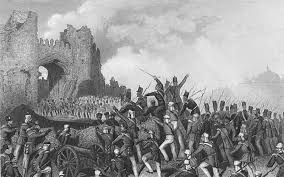- The First War of Indian Independence, often referred to as the Sepoy Mutiny or Revolt of 1857 by the British, is regarded by many historians, particularly Indian nationalists, as the first major armed uprising against British colonial rule in India. It is a landmark event in India’s struggle for independence.
- The rebellion began among Indian soldiers (sepoys) in the British East India Company’s army, triggered by a combination of military, social, political, and religious grievances.
- Military Grievances: Sepoys were poorly treated, underpaid, and overworked. They also felt alienated by the British.
- Religious and Cultural Issues: The introduction of reforms by the British, such as the use of new cartridges rumored to be greased with animal fat (offensive to both Hindu and Muslim soldiers), further escalated tensions. Additionally, the British practice of requiring Hindu soldiers to travel overseas, against their religious beliefs, added fuel to the fire.
- Political Discontent: The British annexation policies, particularly the Doctrine of Lapse, which allowed annexing states without a male heir, angered many Indian rulers, leading to their resistance.
- Economic Exploitation: The economic policies of the British led to severe distress for the Indian peasantry and artisans, contributing to widespread dissatisfaction.
- The rebellion began on 10 May 1857 in Meerut, where sepoys first revolted against the British. The mutiny spread rapidly to other regions, including Delhi, Kanpur, Lucknow, Jhansi, and Bareilly.
- Iconic figures emerged from the rebellion:
- Rani Lakshmibai of Jhansi, a warrior queen, became one of the most famous leaders.
- Begum Hazrat Mahal of Lucknow played a key role in organizing the resistance in her region.
- Mangal Pandey, a sepoy who was among the first to rise against British officers, became a symbol of the rebellion.
- The rebels initially captured Delhi, and Bahadur Shah Zafar, the last Mughal emperor, was declared the symbolic leader of the uprising. However, the British quickly regained control of the city.
- After months of intense fighting, the British suppressed the rebellion with brutal force, employing massacres and reprisals against both rebels and civilians.
- The British East India Company was dissolved in the aftermath, and direct control of India was transferred to the British Crown in 1858, marking the beginning of the British Raj.
- Although the rebellion failed to overthrow British rule, it had several significant and lasting impacts on India:
- Administrative Reforms: It led to changes in the way India was governed by the British.
- Nationalist Awakening: The rebellion galvanized the Indian population and sowed the seeds for future nationalist movements.
- Inspiration for Future Leaders: The uprising inspired future freedom fighters, including leaders like Bal Gangadhar Tilak, Lala Lajpat Rai, and Subhas Chandra Bose, who continued the struggle for India’s independence.
- The 1857 rebellion is considered a pivotal event in the history of India’s independence movement. Though it did not succeed in overthrowing British rule, it represented the first large-scale, organized resistance to British rule in India, involving a wide range of Indian society, from sepoys to peasants to princely rulers.
- The event laid the groundwork for a more unified nationalist movement, which would ultimately culminate in India’s independence in 1947.
- The First War of Indian Independence of 1857 (known as the Sepoy Mutiny or Revolt of 1857) was a critical turning point in India’s fight against colonialism.
- It was the first large-scale, organized resistance to British rule and played a significant role in the history of India’s eventual independence.
- Although the rebellion was suppressed, it had lasting effects, inspiring future movements and leaders in the struggle for freedom.







